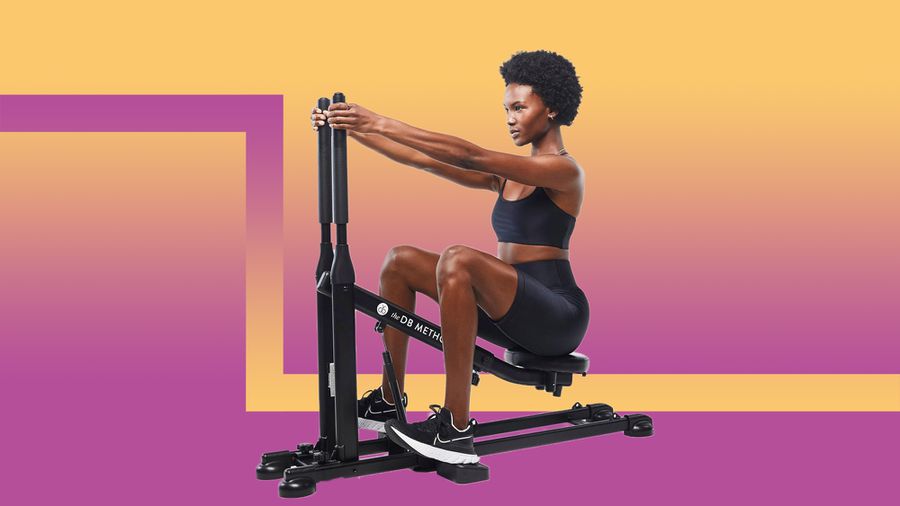We independently research, test, review, and recommend the best
products—learn more about
our process. If you buy something through our links, we may earn a commission.

One thing about your rear being on the back side of your body is that you don’t really get to look at it all that often. For months upon months, I got away with ignoring one of the more tangible effects of the stay-in-place COVID lifestyle. The fit of my pants felt different, but they still buttoned up so I told myself that I was just getting used to wearing sweats ninety-nine percent of the time and imagining things. Finally, though, I turned around in front of the mirror and faced the facts. Ah yes. My backside was no cartoon peach. It reminded me more of the dejected face emoji (😞), whose downcast eyes perfectly illustrated my collapsing cheeks.
Stuck at home and mourning my pre-times posterior, I was a prime candidate to try The DB Method (Buy It, $329, thedbmethod.com), the at-home squat machine that booty ambassador than Kim Kardashian has credited for building up her shapely backside. FTR, other fans include Hailey Bieber, Tracee Ellis Ross, and even Martha Stewart.
The DB (short for Dream Butt) machine supposedly targets the three muscles that make up your buttocks: the gluteus maximus, gluteus medius, and gluteus minimus. The butt is a pivotal player in an entire body’s functionality, and this especially holds true for women, according to Erik Korem, Ph.D., a Houston sports scientist who has worked with collegiate and Olympic athletes. “The glutes help you move, and they keep your hips aligned,” says Korem. “They’re also very important for preventing pelvic floor dysfunction.” (
I can't say the machine vibed with my cozy home decor, and for days I eyed it warily. My gymnast daughter became obsessed, perching on the seat while she read Ivy and Bean books. On the night of post-vaccination celebration dinner with my parents, my 70-year-old father wandered over and gave it a straddle. "This is fun!" he said. It was my turn.
One of the most appealing facets of The DB Method is that it doesn’t ask too much of its user. The majority of the 24 DB Method workouts on the accompanying app are shorter than ten minutes. What’s more, the actual move at the center of the workout is not remotely torturous; using the machine feels similar to stretching out on a Pilates machine in that you’re guided through the motion with just a touch of resistance. (It just burns a little more.)
Once I’d mastered the fundamentals, thanks to five short and sweet introductory videos, I jumped around the other offerings. I loved the video with Aliya Sims, a New York-based boxing instructor, whose upbeat yet relaxing series of plié squats and hip exercises helped me feel stretched. Although the machine was developed first and foremost to encourage that ideal butt-targeting squat-based movement pattern, you can, indeed do other exercises with it.
I tried the bulk of the videos, from Cardio Conditioning and Sculpt to an advanced class named “The Gladiator” (which opens, rather hilariously, with trainer Eddie Carrington sharing his “Gladiator strategy: Start strong stay strong, and finish strong”). Motivation mumbo jumbo aside, it was fun to see how the roster of coaches came up with new ways to use the same piece of equipment. Most of the classes were entirely on the machine, though not always as you’d imagine. One of the more inventive adaptations was using the seat as resistance for arm exercises. I got the hang of it. Performing standing crunches — which involved placing my hands on the seat and pushing it away by activating my core — was slightly more awkward. One of the most wonderful classes, Hip Mobility, with personal trainer and fitness model Allegra Paris, skipped the contraption altogether. Her ten minutes of hip-focused mat exercises were like a distillation of my favorite stretches in yoga.
I also started using it my own way, wandering away from my computer whenever I needed a break from my work and hopping on the machine. The up and down motions paired especially well with a Margaret Atwood audiobook, I discovered (I liked the wry narration much better than the video game-y electronic music in the background of the recorded videos). The meditative quality set in as my entire body moved in subtle arcs was akin to what happens when I go swimming. Only my butt burned more.
All things told, I’m not sure I can say The DB merited the space it took up in my apartment. But we had fun for a while there, the DB and I, and were I to wake up and discover I owned a home gym like Martha Stewart or the Rock (read: bigger than my entire apartment), I’d happily hop back on the buttwagon. Two weeks into my adventure in butt burning, my body felt better cared for than it had before. More to the point, my pants weren’t playing tricks on me anymore. I even bought a new pair to celebrate.






































